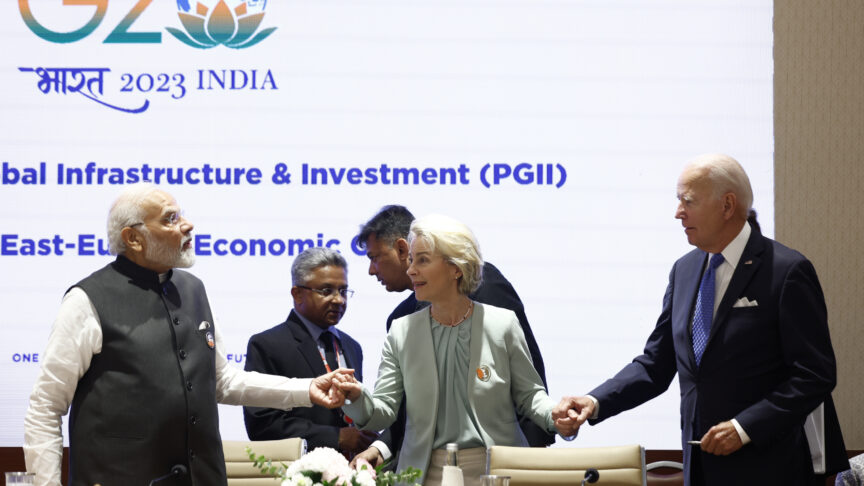Coming to terms with China’s maritime power
China's naval power is already presenting Europe with direct challenges and opportunities
When Europeans think of naval power, maritime security, and China, they think of the militarised artificial islands in the South China Sea. They rightly associate them with legal issues of freedom of navigation and the risk of a clash between the People’s Liberation Army (PLA) and the United States-Japan alliance. Inevitably, this line of thinking leads to the conviction that Europe only has limited means to shape the maritime security environment in east Asia. But the issue of naval power has already moved to areas that present Europe with direct challenges and opportunities.
Europeans should not be surprised when in five years’ time the People’s Liberation Navy (PLAN) docks one of its aircraft-carriers at China’s new naval base in Djibouti, which is currently under construction. While a Chinese bombing campaign in the Gulf or in eastern Africa is unlikely, airstrikes from such a carrier are not completely out of question if the PLA is invited by a sovereign state to intervene militarily, on the model of Russian intervention in Syria, or as part of a multinational coalition with a United Nations Security Council mandate. “Military operations other than war” (非战争军事行动) could put China’s new expeditionary force to use serving the country’s “overseas interests” (海外利益) − a term included in Chinese official documents since 2012 and which covers the protection of Chinese nationals and assets overseas.
The possibility of using military power in counter-terror missions has been integrated into China’s toolbox since the December 2015 ‘Counter-Terrorism Law’. With a fleet of three aircraft carriers – and Chinese analysts now openly discussing a future force of six battle groups – China will command a greater number of options to influence international crisis management.
States use aircraft carriers to win naval battles and project air power, but also for deterrence and diplomatic signalling. In the words of a military analyst recently interviewed in Beijing, “carriers are the closest tool to Sun Tzu’s teaching of subduing adversaries without fighting”.[1] One easily imagines the PLAN’s battle group providing a shield to a large non-combatant evacuation operation. Now a standard response to eruptions of violence overseas where there are large numbers of Chinese nationals, the country has conducted 17 such operations in a little more than a decade. But so far these have all been conducted from relatively safe operation theatres not requiring air superiority.
Aircraft carriers are the most visible side of China’s maritime power – the side also played up by the Chinese media as the striking symbol of a ‘new normal’. They are part of a massive and ongoing investment in shipbuilding, naval capacities, and marine science and technology. It has been five years since building a “great maritime power” (海洋大国) became a national strategic goal. The upcoming 19th Party Congress this autumn will certainly re-emphasise this objective, further consolidating the status of the PLAN as the key service providing protection to the next phase of China’s economic globalisation, characterised by higher levels of foreign direct investment, contracted infrastructure projects, and their associated loans.
In China’s official Military Strategy, published in 2015, oceans are a “critical security domain”, together with outer space and cyberspace. The document makes clear that the country’s maritime security posture has already shifted with “open seas protection” complementing offshore defence. Rumours circulate in China that the country will soon issue its first maritime strategy paper. Some fundamental questions are still subject to much internal debate. How to reconcile Xi Jinping’s plans for a Maritime Silk Road linking European and Chinese ports with disputes and risks over maritime boundaries and islands in East Asia? Does China need to choose between being a land power and a sea power? How central will power projection be in the future force structure of the PLAN, by comparison with undersea nuclear deterrence? Should the defence of the Maritime Silk Road determine the future posture of the PLAN?
The question of how to deal with China’s changing posture as a global security actor, and the new political options that a powerful navy will offer to Beijing is of crucial importance to Europe. Djibouti is a test case. China’s permanent naval presence will allow for a modest increase in Europe-China security cooperation. The European Union is planning to upgrade existing interactions with the Chinese navy, which so far are limited to annual modest joint naval exercises in the Gulf of Aden, and joint escorts of World Food Programme shipments to Somalia. This is likely to remain low profile but a process of engagement with China on operations with a human security dimension is in Europe’s interest.
Furthermore, and less immediately obvious, there is a crucial economic dimension to the Chinese naval build-up, and innovation is the key battlefield for Europe. Parallel to spending on the navy, the marine economy is a priority of China’s 13th Five-Year Plan. The State Oceanic Administration and the Ministry of Science and Technology recently issued a roadmap setting up R&D priorities to boost science and technology innovation. Ocean engineering and “high-tech ships” are one of the ten strategic sectors of “Made in China 2025”, the country’s latest plan to lead globally on technological innovation. What is at stake for Europe is the long-term competitiveness of its own marine economy. This applies to competition on international export markets for ships, from naval systems to luxury cruise ships. Many analysts are dismissive of the current level of Chinese technologies, but this misses the upward trend and the political commitment of the Chinese leadership. As such, Chinese progress should be an incentive to consider policies that preserve the competitiveness of European industries.
Much of Europe’s response – or lack thereof – to the Chinese naval buildup will depend on China’s future clarification regarding its maritime strategy. But China did not need a sophisticated maritime strategy to invest massively in new capacities – the simple idea of wanting to become a major maritime power was sufficient. As this unfolds, the worst-case scenario for Europe is the emergence of a Chinese maritime strategy that relies too much on naval power, but does undermine the rules-based order, and shows little interest in international cooperation. After last year’s South China Sea arbitration ruling, China has tended to see maritime law as a tool of the West, rather than a part of a rules-based order. China’s decision to ignore the tribunal’s ruling has created an uneasy status quo, exposing a new international division with regards to the universal value of the United Nations Convention on the Law of the Sea. Turning a blind eye on this division is not sustainable, as problems will resurface, and there is a risk that this divergence of interpretation evolves into a larger challenge against the rules-based order. Avoiding such an outcome has to be both the guiding principle for engagement with the PLAN and an element of Europe’s thinking regarding its own naval capabilities.
[1] Author’s interview with senior military officer, Beijing, May 2017.
The European Council on Foreign Relations does not take collective positions. ECFR publications only represent the views of their individual authors.


